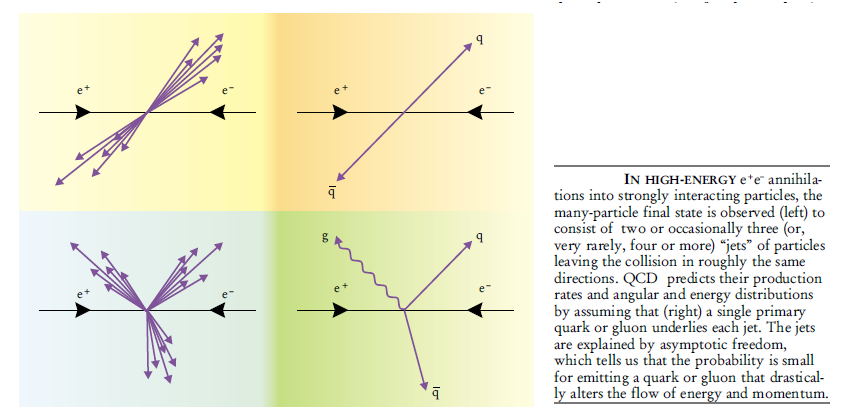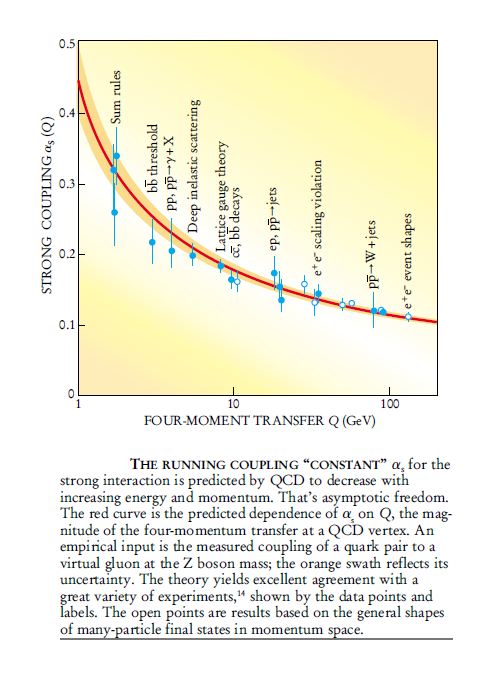QCD - EXTREME VIRTUALITY

The figure above presents a representation of the QCD's most fundamental simplification. On the left, we can witness collision events where very energetic electron-positron annihilations form strongly interacting particles (hadrons), which have the appearance of jets. In the final condition, there are a lot of particles, but the majority of them are clearly arranged into a few collimated "jets" of particles that all face the same direction. 6 There are just two jets that emerge in opposite directions in around 90% of these hardron-producing events. Three jets can be seen sporadically-in roughly 9% of the hadronic final states.
Those collisions and multiparticle hadronic events where leptons, like muons, are created. That is scenario, one only sees a muon around 99% of the time. and an opposing particle known as an antimuon. But Every so often-in roughly 1% of the muonic final states-a A photon is also released.
If history had occurred in a different order, scientists would have proposed that jet-like hadronic final states exhibit underlying phenomena similar to those seen on the right-hand side of the above picture. They would be too strikingly similar to leptonic scattering and QED to be disregarded.
In the end, physicists would have inferred directly from the experimental data that there are light spin-1/2 and massless spin-1 objects hiding beneath the appearances, and how these covert objects couple to one another. They would have done this by examining the specifics of how energy was distributed among the jets and the relative probabilities of different angles between them. They could have even discovered information regarding the coupling of the spin-1 particles to one another by examining the unusual 4-jet events. Therefore, all of the fundamental couplings that we are aware of in QCD may have been deduced, more or less directly, from experiment. However, there would still be one major conundrum: Why are there jets as opposed to just particles?
The solution is insightful and full of repercussions. It is that what determines how strongly gluons couple? dramatically on their momentum and energy. Hard gluons, which pair weakly and have high energy and momentum; While the "soft" gluons, which are less energetic, pair firmly. As a result, a quick-moving coloured quark or Gluons release "radiation" that drastically reroutes the movement of momentum and energy. That clarifies the One observes collimated flows in jets. Alternatively, there The jets' high particle content is explained by the possibility of a significant amount of soft radiation. Therefore, in a strict and We actually get to witness the quarks and other subatomic particles in a Gluons, but as energetic flows rather than discrete particles.

Asymptotic freedom is the term we use to describe the phenomenon of weak coupling for hard gluons but high coupling for soft gluons. 7 Although the concept is expressed in rigorous equations, the name is whimsical. It enables us to make quantitative predictions about the frequency of hard-radiation events in strong interactions of various types and energy. The above picture illustrates the abundance of direct data that supports the key hypothesis that gluon coupling strength declines with increasing energy and momentum. 8 It should be noted that several of the individual points in the image combine data from hundreds of separate measurements, all of which must be fitted using just one movable parameter (the quark-gluon coupling determined by the Z-boson mass).
The historical record was false. a requirement for asymptotic There was freedom in depicting the intense encounter. figured out from far more oblique hints, and QCD was first put forth as the strong interaction theory due to the fact that it is effectively the only quantum field theory with asymptotic freedom.9 concepts, the presence of jets and their primary characteristics, before they were experimentally discovered, were expected.
